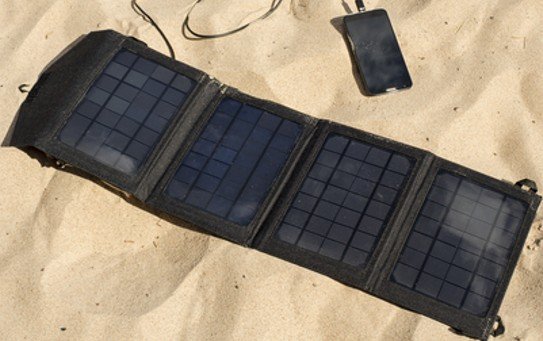ElectricityMatch is dedicated to helping you lower your electric bill. We usually focus on topics like innovative electricity rates, energy supplier reviews, and energy conservation. Our world, however, is becoming increasingly mobile. We are not always within a charging cable’s reach of an electrical outlet. Powering our electronic devices on the go can be a challenge.
Portable solar power may be the answer for some remote charging situations. The basic components of this system are the power pack and the solar panels. There are a growing number of portable solar charging systems on the market. Some manufacturers only specialize in either the power pack or the portable solar panels while others sell all-in-one systems.
Power Packs
The power pack market is saturated. There is a seemingly endless list of manufacturers, models, sizes, shapes, and designer colors. The power pack simply stores electricity. It is essentially a rechargeable battery with a USB interface. You can charge it up from a wall outlet, USB port, or portable solar panels. Improvements in lithium-ion battery technology have made power packs compact and lightweight. Most power packs can deliver a nearly full-speed recharge for your portable device. You just need to make sure the power pack charging capacity matches the needs of your smartphone, tablet, or other device.
Check the specs from the power pack manufacturer to make sure it is the right size. The important numbers are the capacity and the charging port amps. Capacity is measured in milliamp-hours (mAh). Smartphones require anywhere from 1800 to 2800mAh for a full recharge. Tablets can take 5000 to 7000mAh depending on the size of the device. Charging ports usually come rated as either 1A or 2.1A. You will get a faster charge from 2.1A port and it is better-suited for high drain devices.
Solar Panels
Sometimes you need power and an AC outlet is nowhere in sight. This is where portable solar panels are gaining popularity. Manufacturers like Goal Zero and Anker offer portable solar panels ideal for hiking, camping, or a day at the beach. Some portable solar panels can be used to directly charge portable devices. However, they work best when used to charge a power pack. Charging a power pack with solar panels allows you to store power for use when the sun is not shining.
Charging a power pack with solar panels can be a lengthy process. The size of the panels (measured in Watts) and the storage capacity of the power pack affect the charging time. Charging works best in a stationary arrangement where the solar panels can be set up at the optimum angle and left to charge the power pack.
When shopping for these systems, the first task is identifying the devices you need to power up. Are you looking to charge a smartphone, tablet, or laptop? You then need to consider your access to electricity. Do you only need power to get through the day or are you going to be away from an electrical outlet for multiple days?
If you are looking to recharge your devices in a remote location, portable solar power is worth looking into. At least one electricity provider is offering rate plans that include a portable solar recharging system as an enrollment incentive. These systems should become more affordable as consumers continue to look for creative charging solutions.



We use both solar panels and power packs while cycle touring and travelling. It’s great as we don’t always have access to a power supply, and there are certain items like gps and phone, which we rely on during travelling or cycling. I do find the solar panels are great, but sometimes they take a while to charge on just light sources.